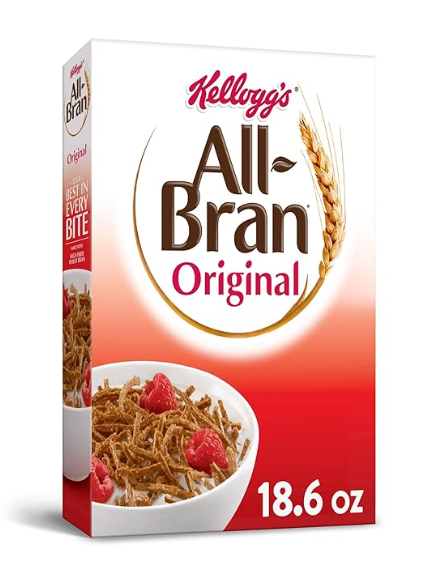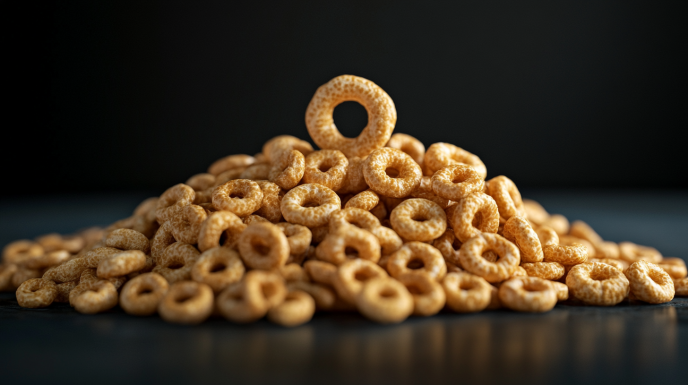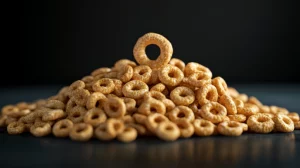
All Bran Breakfast Cereal, 8 Vitamins and Minerals, High Fiber Cereal, Original, 18.6oz Box (1 Box)
- Crunchy high-fiber cereal simply made with wholesome wheat bran; A delicious part of any balanced breakfast
- Enjoy by the bowlful, with yogurt and fruit, and as the base for your favorite savory dishes, desserts, and bread recipes
Discovering the Hidden Power of Whole Grain Goodness in Your Breakfast Bowl
In a world of flashy, sugar-coated breakfast options that promise excitement but deliver little nutritional value, there’s something refreshingly honest about All-Bran cereals. These unassuming brown flakes and twigs might not win any beauty contests, but they’ve been quietly supporting digestive health for generations. As someone who’s struggled with digestive issues for years, I’ve come to appreciate that sometimes the most powerful health allies come in the most humble packages.
Let’s face it—most of us don’t wake up thinking about our fiber intake. But perhaps we should. The simple act of choosing a high-fiber cereal like All-Bran could be the single most important dietary decision you make for your long-term digestive health. This isn’t just marketing hype; it’s backed by decades of nutritional science showing the profound impact dietary fiber has on everything from regularity to reducing disease risk.
I remember the first time I poured a bowl of All-Bran, skeptically eyeing those dark brown flakes and wondering if I was making a terrible breakfast mistake. Fast forward several years, and I’m something of an All-Bran evangelist. Not because it’s the most delicious thing I’ve ever tasted (though I’ve come to enjoy the nutty flavor), but because of how dramatically it changed my digestive health and overall wellbeing.
So grab a bowl and your favorite milk alternative (yes, we’ll cover whether All-Bran works for various dietary preferences), and let’s dive into everything you never knew you wanted to know about this fiber powerhouse. From its humble wheat bran origins to its impressive nutritional profile, this is the comprehensive guide to understanding why nutritionists consistently recommend All-Bran cereals as part of a healthy diet.
What’s Actually in That Bowl? The Composition of All-Bran Cereal
At its core, All-Bran cereal is refreshingly simple. The primary ingredient is wheat bran—the outer layer of the wheat kernel that’s typically removed during the refining process to make white flour. This bran layer contains most of the fiber found in wheat, along with various nutrients and antioxidants.
Traditional All-Bran Original contains wheat bran, sugar, malt extract, salt, and various added vitamins and minerals. The ingredient list is relatively short compared to many breakfast cereals, which can be a good sign when you’re looking for less processed food options.
What makes All-Bran stand out nutritionally is its fiber content. While most Americans struggle to reach the recommended 25-38 grams of daily fiber (with most getting only about 15 grams), a single serving of All-Bran Original provides approximately 10-12 grams of fiber—nearly half the daily requirement for some individuals. That’s impressive for a simple breakfast food!
The wheat bran in All-Bran is particularly rich in insoluble fiber, which adds bulk to stool and helps food pass more quickly through the digestive system. This type of fiber doesn’t dissolve in water but rather absorbs water as it moves through your digestive tract, effectively acting like a broom that sweeps through your intestines.
Beyond fiber, All-Bran cereals are typically fortified with essential vitamins and minerals. Most varieties contain added iron, B vitamins (including folic acid, B6, and B12), and sometimes vitamin D and calcium. This fortification helps address nutritional gaps that might exist in your diet, making your breakfast bowl not just a fiber source but a multi-nutrient boost to start your day.
The Fiber Factor: Why All-Bran Stands Out
When it comes to fiber content, All-Bran cereals are in a league of their own. Depending on the specific variety, a standard serving (typically around 1/2 cup) can provide anywhere from 8 to 14 grams of fiber. To put this in perspective, that’s about the same amount of fiber you’d get from eating 4-5 apples—all in one convenient bowl.
This high fiber content places All-Bran among the highest-fiber cereals available on supermarket shelves. While many cereals might claim to be “high in fiber,” few deliver the concentration found in All-Bran products. Most popular breakfast cereals contain only 2-3 grams of fiber per serving, and many have less than 1 gram.
The type of fiber in All-Bran is predominantly insoluble fiber from wheat bran. This specific type of fiber has been studied extensively for its effectiveness in promoting regularity and preventing constipation. Unlike soluble fiber (found in foods like oats and beans), which forms a gel-like substance in water, insoluble fiber maintains its structure. This property helps increase stool bulk and reduces transit time through the digestive tract—essentially keeping things moving smoothly.
For those keeping track of their fiber intake for health reasons, All-Bran offers a convenient way to make significant progress toward daily fiber goals with just one meal. Given that most Americans only consume about half the recommended daily fiber, incorporating a high-fiber cereal like All-Bran can make a substantial difference without requiring major dietary overhauls.
Beyond Regularity: The Surprising Health Benefits of All-Bran Cereal
While most people associate high-fiber cereals like All-Bran with digestive regularity, the health benefits extend far beyond preventing constipation. Research has shown that diets high in fiber, particularly the type found in wheat bran, may offer protection against several serious health conditions.
First, there’s the heart health connection. Studies have shown that diets rich in fiber may help reduce LDL (bad) cholesterol levels, potentially lowering the risk of heart disease. The specific mechanisms aren’t fully understood, but fiber appears to bind with cholesterol in the digestive system, preventing it from being absorbed into the bloodstream.
Weight management is another area where All-Bran may prove helpful. High-fiber foods tend to be more filling, creating a sense of satiety that can help prevent overeating. Additionally, fiber slows digestion, helping stabilize blood sugar levels and prevent the spikes and crashes that can trigger hunger. A bowl of All-Bran in the morning might help you feel satisfied longer than a low-fiber breakfast alternative.
Perhaps one of the most significant potential benefits relates to colon health. Several studies have suggested that diets high in wheat bran fiber may reduce the risk of colon cancer. While this research isn’t conclusive, the association between higher fiber intake and lower colon cancer risk has been observed in multiple population studies.
There’s also emerging research on the relationship between fiber intake and gut microbiome health. While insoluble fiber isn’t typically considered a prebiotic (food for beneficial gut bacteria) in the same way as soluble fiber, it does contribute to a healthy intestinal environment that supports beneficial bacteria populations.
For women specifically, there may be additional benefits. Some research suggests that high-fiber diets might help reduce the risk of breast cancer, possibly by binding to estrogen in the digestive tract and removing it from the body.
The All-Bran Family: Exploring Different Varieties
Over the years, the All-Bran product line has expanded beyond the original cereal to include various flavors and formats, catering to different taste preferences while maintaining the focus on high fiber content.
All-Bran Original remains the flagship product, featuring the classic small, dark brown flakes that provide approximately 10-12 grams of fiber per serving. This is the most fiber-dense option in the lineup and has the most pronounced wheat bran flavor.
All-Bran Complete Wheat Flakes offers a more traditional flaked cereal appearance and texture, with slightly less fiber than Original (typically around 8-9 grams per serving) but a milder flavor profile that some find more approachable.
For those who prefer a sweeter breakfast option, All-Bran has introduced versions with added flavors like fruit. These varieties typically maintain high fiber content while incorporating dried fruits or flavor additions to make the cereal more palatable for those unaccustomed to the somewhat austere taste of pure wheat bran.
There have also been limited-edition and regional varieties of All-Bran available in different markets around the world, including honey-flavored versions and varieties with added seeds or nuts for textural variation.
The multiple format options mean you can choose an All-Bran product that matches your taste preferences while still benefiting from significant fiber content. For those new to high-fiber cereals, the flavored varieties or Wheat Flakes might offer a gentler introduction than jumping straight to Original.
Dietary Considerations: Is All-Bran Right for Your Lifestyle?
While All-Bran offers impressive nutritional benefits, it’s not universally suitable for all dietary needs or restrictions. Understanding how it fits (or doesn’t fit) with various dietary patterns is important when considering whether to include it in your breakfast rotation.
For those following a gluten-free diet due to celiac disease or non-celiac gluten sensitivity, traditional All-Bran cereals are not suitable options. Wheat bran, the primary ingredient, contains gluten. However, some markets offer gluten-free high-fiber cereal alternatives made from rice bran or other gluten-free grains, though these aren’t sold under the All-Bran brand name.
Vegans and vegetarians will generally find All-Bran products compatible with their diets. The cereals themselves don’t contain animal-derived ingredients, though vegans will want to pair them with plant-based milk alternatives rather than dairy milk.
For those watching their sugar intake, it’s worth noting that most All-Bran varieties do contain some added sugar, though generally less than many other commercial cereals. The Original variety typically contains around 6 grams of sugar per serving—modest compared to many breakfast cereals but still something to be aware of if you’re strictly limiting sugar.
Individuals managing diabetes may find All-Bran’s high fiber content beneficial for blood sugar management. The fiber helps slow the absorption of carbohydrates, potentially reducing blood sugar spikes. However, the presence of some added sugar means portion control remains important.
Those following low-carb or ketogenic diets may find All-Bran too carbohydrate-heavy for their plans, as a typical serving contains around 22-25 grams of total carbohydrates, though the high fiber content means net carbs are lower.
Making All-Bran Delicious: Beyond the Basic Bowl
Let’s address the elephant in the room: All-Bran, particularly the Original variety, isn’t known for its irresistible flavor. The taste is distinctly wheaty with a slight bitterness that some find challenging. However, there are numerous ways to make this nutritional powerhouse more palatable without sacrificing its health benefits.
The simplest approach is to combine All-Bran with a sweeter, more flavorful cereal. Try mixing it in a 1:1 ratio with your favorite granola or a fruit-flavored cereal. You’ll dilute the fiber content somewhat but still get a significant amount while improving the taste profile.
Fresh fruits can transform a bowl of All-Bran. Berries work particularly well—their natural sweetness and acidity balance the cereal’s earthiness. Sliced bananas add sweetness and a creamy texture that complements the crunchiness of the bran flakes. For a tropical twist, try mango chunks or kiwi slices.
Don’t underestimate the impact of your milk choice. A creamy oat milk or vanilla-flavored almond milk can add sweetness and mask some of the bran’s stronger flavors. For those who consume dairy, whole milk provides richness that balances the cereal’s austerity.
A drizzle of honey or maple syrup adds sweetness more naturally than the pre-sweetened varieties, and you can control exactly how much you’re adding. A sprinkle of cinnamon not only adds flavor but also has blood sugar-regulating properties that complement the fiber’s similar effect.
For a more substantial breakfast, try creating an All-Bran parfait: layer the cereal with Greek yogurt and fresh fruit in a glass for a visually appealing and texturally interesting meal.
Beyond Breakfast: Creative Uses for All-Bran in Cooking
While most people think of All-Bran exclusively as a breakfast cereal, its high fiber content and crunchy texture make it a surprisingly versatile ingredient in the kitchen. Here are some unexpected ways to incorporate All-Bran into your cooking:
All-Bran makes an excellent crunchy topping for casseroles. Crush it slightly and mix with a small amount of melted butter or olive oil, then sprinkle over vegetable casseroles before baking for a fiber-rich alternative to breadcrumbs.
For baking enthusiasts, All-Bran can add fiber and texture to muffins, quick breads, and cookies. The classic All-Bran muffin recipe has been printed on the box for generations, featuring the cereal soaked in milk to soften it before incorporating into a simple muffin batter. These hearty muffins make perfect grab-and-go breakfasts or snacks.
All-Bran can be incorporated into homemade energy bars or balls. Combine crushed cereal with nut butter, honey, dried fruits, and seeds, then press into a pan or roll into balls for fiber-rich snacks that are perfect for hiking or afternoon energy slumps.
For a crispy coating for baked chicken or fish, crush All-Bran and mix with herbs and spices. The result is a high-fiber alternative to traditional breadcrumb coatings that adds a pleasant crunch and nutty flavor.
All-Bran can even be used to add fiber to smoothies. Pre-soak it in your liquid of choice to soften it first, then blend with fruits and other smoothie ingredients. The cereal adds thickness and fiber without significantly altering the flavor profile of your smoothie.
The Digestive Revolution: How All-Bran Supports Gut Health
Perhaps the most well-documented benefit of All-Bran is its impact on digestive health. The high concentration of insoluble fiber works methodically to improve several aspects of digestive function.
First, insoluble fiber adds bulk to stool. This increased volume stimulates the intestinal muscles, promoting peristalsis—the wave-like contractions that move food through your digestive system. For people struggling with constipation, this mechanical stimulation can be particularly beneficial.
The bulking effect of fiber also helps speed transit time—the duration food spends moving through your digestive tract. Optimal transit time is important not just for comfort but also for health; food that moves too slowly through the colon can lead to increased absorption of certain compounds that might be better eliminated.
All-Bran’s fiber also acts as a natural intestinal cleanser. As the rough fiber particles move through your digestive tract, they gently scrub the intestinal walls, helping remove accumulated debris and possibly reducing the concentration of potentially harmful substances that might otherwise remain in contact with intestinal tissues.
For those with specific digestive conditions like irritable bowel syndrome (IBS), fiber’s effects can be complex. While some IBS sufferers find relief with increased fiber intake, others may experience worsened symptoms, particularly if fiber is increased too rapidly. This is why gradual introduction is recommended—start with a small portion of All-Bran and slowly increase over time as toleration improves.
Beyond its mechanical effects, the fiber in All-Bran may influence gut microbiota—the vast community of bacteria living in your digestive tract. While insoluble fiber isn’t directly metabolized by gut bacteria in the same way as soluble fiber, it does influence the intestinal environment and may indirectly support beneficial bacterial populations.
Comparing All-Bran to Other High-Fiber Options
The breakfast cereal aisle offers numerous products claiming to provide high fiber content, from oat-based granolas to psyllium-enriched flakes. How does All-Bran stack up against these alternatives?
In terms of absolute fiber content per serving, few mainstream cereals can match All-Bran Original’s 10-12 grams per serving. Some competitors offer 5-8 grams, while most “regular” cereals provide only 2-3 grams per serving. This concentration makes All-Bran particularly efficient for those specifically seeking to increase fiber intake.
The type of fiber differs among cereals as well. Oat-based cereals like traditional oatmeal provide predominantly soluble fiber, which forms a gel-like substance in water and is known for its cholesterol-lowering properties. All-Bran’s wheat-based insoluble fiber, by contrast, excels at promoting regularity and digestive movement. Ideally, a healthy diet includes both types of fiber, so there’s value in varying your fiber sources.
Sugar content is another important comparison point. Many fiber-enriched cereals compensate for fiber’s sometimes bitter taste by adding significant amounts of sugar—sometimes 12-15 grams per serving. All-Bran varieties typically contain more modest amounts (around 6 grams per serving for Original), making them a better option for those monitoring sugar intake.
Cost-effectiveness is worth considering too. While All-Bran products are not typically the cheapest cereals on the shelf, when evaluated on a “cost per gram of fiber” basis, they often represent good value. Getting the equivalent amount of fiber from some premium granolas or specialized health food cereals might cost significantly more.
The Nutritional Profile: Calories, Vitamins, and Minerals in All-Bran
Beyond its star fiber content, understanding All-Bran’s complete nutritional profile helps put this cereal in proper context within a balanced diet.
Calorie-wise, All-Bran is relatively modest. A standard 1/2 cup serving of All-Bran Original contains approximately 80 calories—significantly lower than many granolas (which can reach 200-300 calories per serving) and comparable to or lower than many conventional cereals. This moderate calorie content makes it compatible with weight management goals.
All-Bran cereals are typically fortified with a range of vitamins and minerals. A standard serving often provides 25-100% of the Daily Value for several B vitamins, including thiamin, riboflavin, niacin, B6, B12, and folic acid. These B vitamins play crucial roles in energy metabolism and nervous system function.
Iron fortification is another common feature, with a serving typically providing around 45-60% of daily iron needs. This can be particularly valuable for women of reproductive age, who have higher iron requirements and are more prone to deficiency.
Many All-Bran varieties also contain added vitamin D and calcium, nutrients important for bone health that many Americans don’t consume in sufficient quantities. The specific levels vary by product and may differ in international markets.
Sodium content is a consideration for those monitoring salt intake. All-Bran products typically contain around the 250-350mg range per serving—moderate but not insignificant. This represents about 10-15% of the recommended daily sodium limit.
The protein content is modest, typically around 4-5 grams per serving. While not a major protein source, this does contribute to the overall protein intake for the day, especially when the cereal is consumed with milk or yogurt.
Starting Your All-Bran Journey: Tips for Fiber Newcomers
If you’re new to high-fiber cereals like All-Bran, diving in too quickly can lead to digestive discomfort. Here are some practical tips for incorporating All-Bran into your diet gradually and comfortably:
Begin with a small portion—perhaps just 2-3 tablespoons mixed with your regular cereal. This introduces your digestive system to the higher fiber content without overwhelming it. Over several weeks, gradually increase the proportion of All-Bran while decreasing your regular cereal.
Hydration is crucial when increasing fiber intake. Fiber absorbs water, and without sufficient fluid intake, it can actually worsen constipation rather than improve it. Aim to drink at least 8 ounces of water with your All-Bran and maintain good hydration throughout the day.
Pay attention to timing. Some people find that consuming high-fiber foods like All-Bran in the morning helps establish a regular digestive rhythm, while others might experience discomfort if they’re not accustomed to much fiber at breakfast. Experiment to find what works for your body.
If you experience bloating or gas when first introducing All-Bran, don’t be discouraged. These symptoms typically subside as your digestive system adjusts to the higher fiber intake. The key is gradual introduction rather than sudden large changes.
Consider pre-soaking your All-Bran in milk or a milk alternative for 5-10 minutes before eating. This softens the cereal slightly and can make it easier to digest, particularly for those with sensitive digestive systems.
The Verdict: Is All-Bran Worth Adding to Your Shopping Cart?
After examining All-Bran from multiple angles—nutritional content, taste, versatility, and health benefits—the question remains: does this cereal deserve a place in your pantry?
For most people, the answer is a qualified yes. The exceptional fiber content alone makes All-Bran a standout option in a food landscape where most products fall woefully short on this essential nutrient. The potential benefits for digestive health, heart health, weight management, and overall wellbeing make a compelling case for including some form of All-Bran in your dietary rotation.
The qualification comes down to individual factors: dietary restrictions that might preclude wheat products, personal taste preferences, and specific health conditions that might be affected by high-fiber foods. As with any dietary choice, the decision should be personalized based on your unique needs and circumstances.
For those who find the taste challenging, remember that All-Bran doesn’t need to be consumed in isolation. Mixed with more flavorful cereals, topped with fruits, or incorporated into recipes, it can provide its nutritional benefits without dominating your palate.
In the context of the typical Western diet—chronically deficient in fiber and heavy on refined carbohydrates—All-Bran represents a simple, accessible way to address a significant nutritional gap. While no single food can guarantee health, incorporating fiber-rich options like All-Bran as part of a varied, balanced diet aligns with consistently recommended dietary patterns associated with long-term health and reduced disease risk.
The final verdict? All-Bran may not be the most exciting food in your kitchen, but it might be one of the most functional—a practical tool in your nutritional arsenal that delivers genuine health benefits in a convenient package. Sometimes the most valuable dietary additions aren’t the most glamorous, but rather the reliable workhorses that consistently support our wellbeing day after day, bowl after fiber-filled bowl.




